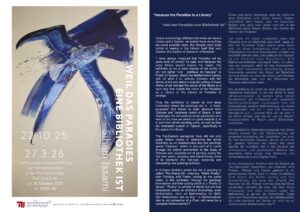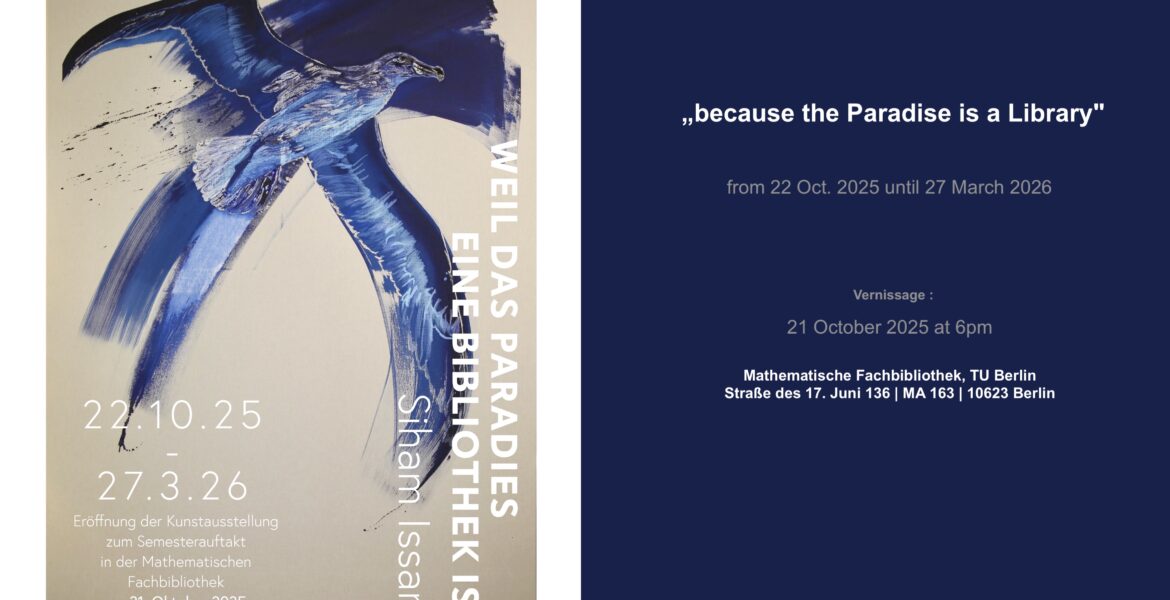
Für Deutsch bitte nach unten scrollen
Cicero convincingly affirmed that when we have a Library and a Garden, we indeed have everything we could possibly need. But Borges went even further in seeing in the Library itself that very Garden, the Garden of Gardens: a Paradise!
“I have always imagined that Paradise will be some kind of Library” he said. And because the artist Siham Issami shares his vision, this exhibition is not a mere display of her works of art, but rather “une poétique de l’espace” (a Poetic of Space), where the Mathematics Library with all what it is, actively interacts with her Works of Art and where a specific setting of those Works of art reshape the space of the library in a such way that enable the vision of the Paradise as a Library or the Library as Paradise to emerge.
Thus the exhibition is meant as one large Installation where the paintings are in a “mise-en-scène” that draws its main structure from Chinese and Japanese notion of Space. It also challenges the conventions of our perception of a work of art: how we direct our gaze towards it, in it, and from which standing point, as well as how we orientated ourself in “Space”, specifically in the space of a library.
The Far-Eastern perception here did not only guide Siham Issami in structuring the whole exhibition as an Installationbut also her paintings series “Oiseaux”, which is one part of it, came through the artist’s submersion in the study of Chinese and Japanese art of painting during the last tree years, adapting and transforming some of its elements into her-own; exploring and reinventing new painting technics.
Cicero war davon überzeugt, dass wir, wenn wir eine Bibliothek und einen Garten haben, tatsächlich alles haben, was wir brauchen. Borges aber ging noch weiter und sah in der Bibliothek selbst diesen Garten, den Garten der Gärten: ein Paradies!
„Ich habe mir immer vorgestellt, dass das Paradies eine Art Bibliothek sein wird”, sagte er. Weil die Künstlerin Siham Issami seine Vision teilt, ist diese Ausstellung nicht nur eine Präsentation von ihren Kunstwerken, sondern sie erschafft vielmehr eine „une poétique de l’espace” (eine Poetik des Raumes): Die Mathematikbibliothek interagiert dabei mit allem, was sie ausmacht, aktiv mit den Kunstwerken, und eine bestimmte Anordnung dieser Kunstwerke gestaltet den Raum der Bibliothek auf eine Weise um, dass die Vision vom Paradies als Bibliothek oder von der Bibliothek als Paradies aufscheinen kann.
Die Ausstellung ist somit als eine einzige große Installation konzipiert, in der die Bilder in einer „Mise-en-scène” zu sehen sind, deren Hauptstruktur auf chinesische und japanische Raumvorstellungen zurückgeht und die Konventionen unserer Wahrnehmung von Kunst herausfordert: wie wir – und von welchem Standpunkt aus – unseren Blick auf sie oder in sie hinein richten, und wie wir uns im „Raum”, insbesondere im Raum einer Bibliothek, orientieren.
Die fernöstliche Wahrnehmungsweise hat Siham Issami sowohl bei der Strukturierung der gesamten Ausstellung als „Installation“ als auch bei ihrer Bilderserie „Oiseaux“, die ein Teil von ihr ist, geleitet. Während der letzten drei Jahre tauchte die Künstlerin tief in das Studium der chinesischen und japanischen Malerei ein, adaptierte dabei einige ihrer Elemente, und verwandelte sie in eine eigene Form.
In der chinesischen Tradition wird die Malerei als „Wu-Sheng-Shi“ bezeichnet, das bedeutet „stille Poesie“, Malerei und Poesie gehören in ein gemeinsames Reich. Auch in dieser Ausstellung wird durch die Bilder selbst und ihre Inszenierung, die eine der „Poetik des Raumes“ ist, die Poesie“ nicht als eine der Worte verstanden, sondern als eine, die über Worte hinausgeht und alles umfasst, sogar die Mathematik, ja gerade die Mathematik. Sagte nicht Karl Weierstrass einmal: „Ein Mathematiker, der nicht irgendwie ein Dichter ist, wird nie ein vollkommener Mathematiker sein“?
